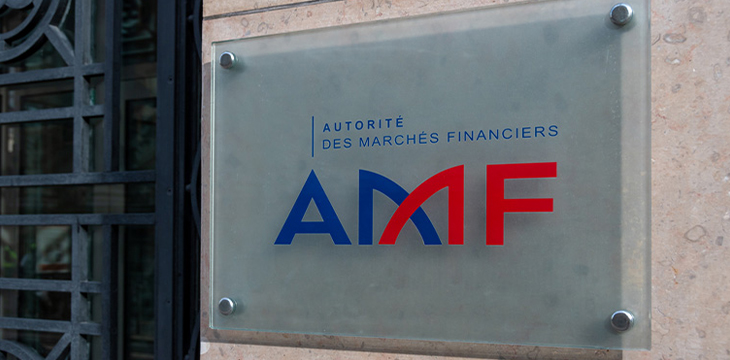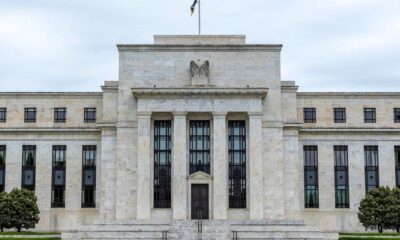DeFi
Decentralization a spectrum, regulation a necessity: Responses to France’s DeFi discussion paper

The Autorité des marchés financiers (AMF), the securities commission of France, published a summary of responses received to a June 2023 discussion paper on decentralized finance (DeFi), with the majority of respondents favoring the idea of decentralization existing on a spectrum and showing support for developing a regulatory framework for DeFi, including increased identity disclosures.
The AMF received 34 responses from various players in the DeFi ecosystem (project initiators, foundations, and blockchain organizations), as well as centralized players from the digital asset sector and from traditional finance, such as service providers, consultancy, and audit firms.
The discussion paper asked respondents to consider the following issues: a definition of and a regulatory approach to DeFi; the nature (permissioned or permissionless) of blockchain protocols; issues linked to smart contracts; and governance-related matters.
“Overall, the responses raised the importance of developing a clear legal framework for DeFi and in this regard elaborated further upon several key concepts, such as the notion of ‘decentralization’ and references to ‘permissioned or permissionless blockchains,’” said the AMF.
The paper began by outlining the fundamental issue of what actually qualifies as ‘decentralized’ before getting into the equally thorny issue of regulation.
Decentralization on a spectrum
The AMF noted that respondents seemed to agree on a couple of key points related to the definition of DeFi: first, that defining the concept would be essential in order to set the boundaries of a regulatory framework, and second, that levels of decentralization can vary from one project to another and should thus be considered along a sliding scale, or ‘spectrum,’ of decentralization.
This certainly seems a logical place to start: eliminating the idea that all DeFi is created equal and equally decentralized or the black-and-white interpretation that an entity is either decentralized or isn’t.
In fact, some have argued that the entire notion of “decentralization” is a myth, and there are, in fact, only different levels of centralization—a semantic point that a few respondents to the AMF discussion paper clearly also made. In pointing out the consensus that decentralization is a spectrum, the regulator noted that the same is true “conversely, of centralization.”
In addition, the AMF reported that some responses highlighted “the potential for a given project to evolve over time, where it may initially appear to be relatively centralised, but could evolve towards greater levels of decentralisation, particularly as it is further adopted by users, when its volume of activity increases, or as its governance becomes more open.”
This might well be the case for some DeFi projects, but again, there are degrees, and the notion of progressing to decentralization has been overplayed by some entities, such as the Ethereum blockchain and its founders.
In order to work towards a more objective measurement of where a firm/project lies on this centralization/decentralization spectrum, some respondents referred to the level of automation of projects, i.e., the more these are subject to automated processes, the more decentralized they might be.
However, the AMF suggested that “the notion of automation would likely not be sufficient in itself to judge of the level of decentralisation, as other factors such as the layout, and distribution architecture of the network on which the project operates could also be taken into account.”
In general, the idea emerged of producing some kind of ‘test of decentralization,’ which would take into account both technical aspects (such as level of automation, use of open-source code, permissioned or permissionless blockchain) and governance aspects (such as absence of control of administrator keys over a protocol or smart contract, absence of a central decision-making entity).
“Nonetheless, it appears difficult to reach a complete consensus among the responses obtained, with some respondents considering that some of the criteria mentioned should not necessarily be retained, while others consider them as central to the definition of DeFi,” said the AMF.
Despite the difficulties in reaching a complete consensus, there was agreement that defining DeFi is an important task worth attempting. With this in mind, the AMF extracted certain criteria from the responses that could, at a minimum, be used to assess an entity’s level of decentralization:
- From a technical standpoint, the level of automation and autonomy of the protocol, the absence of administrator rights or keys (or rights or privileges of a similar nature), and an assessment of the level of transparency of the code used.
- From an operational point of view, the analysis could focus on the characteristics of the activity, identifying whether it is provided in an ‘open’ manner (e.g., via a permissionless blockchain protocol that is accessible to the public) and that no custodial activity is provided via the protocol.
- From a governance point of view, criteria could be retained in order to identify situations of ‘de facto’ or ‘de jure’ control over the protocol by developers or users, considering for instance the levels of distribution in governance tokens held, as well as the effective level of participation of holders in the decision-making process.
In terms of the latter point, the AMF clarified that “it would seem clear however that, in order for an activity to be identified as decentralised, a protocol cannot in any case have a central authority (i.e. a legal entity, individual, or a group of individuals) responsible for the governance of the activity.”
After outlining responses related to what decentralization actually is, the regulator put forward the key findings related to how DeFi should be regulated.
Reflections on regulation
According to the AMF, respondents were in favor of developing a regulatory framework for DeFi, most stressing the importance of clearly defining this to provide players with as much certainty as possible.
“A consensus seemed to emerge in responses on the subject of a regulatory approach that would have the same objectives as the regulation applicable to traditional financial markets, i.e. thereby proposing an approach under the ‘same activity, same risk, same regulatory outcome’ principle,” said the report.
Fortunately, this is essentially the approach to DeFi regulation also proposed by the Bank for International Settlements (BIS), the U.K. Bank of England (BOE), and the EU Markets in Crypto Assets (MiCA) regulation, to which France is subject (or will be when it fully comes into force by the end of the year).
For this reason, the AMF suggested that “the principle of ‘same activities, same risks, same regulatory outcomes’, widely supported in the responses received from respondents, should be applied unambiguously, while taking into account the emerging features brought about by these new activities.”
Some industry players did point out that this approach would be more appropriate where the activities and risks of DeFi are similar to those of centralized finance (CeFi), but as we’ve already seen, the line between DeFi and CeFi is hazy at best, and non-existent at worst, so perhaps this point is moot.
To address specific regulatory challenges posed by DeFi, respondents also suggested that imposing certain obligations would be appropriate, such as disclosing the risks incurred and a mechanism for certifying the code and auditing smart contracts. Respondents also suggested imposing standards on protocol governance, the transparency of the code, cybersecurity, and in relation to anti-money laundering and counter-terrorist financing (AML/CFT) measures.
Permission and governance
The discussion paper also touched on several other topics related to DeFi, including an analysis of permissioned and permissionless blockchain protocols.
Permissioned blockchains restrict access to certain users who need approval to participate, while permissionless blockchains allow anyone to join and participate without approval. The main difference is that permissioned blockchains control who can access and contribute, while permissionless blockchains are open to everyone.
“A number of respondents indicated that DeFi could only be considered in the context of permissionless blockchains,” said the AMF.
This seems a logical suggestion, as any permissioned blockchain raises the question of who the permissioned people are, who approves of joining, and if they qualify as a centralized group/entity.
Once the status of a DeFi project or entity is established, the next major issue becomes governance.
A key discussion point was the ‘pseudonymity‘ of the blockchain, which can contribute to a less transparent governance of DeFi protocols, of which the AMF noted that “responses affirmed the inherent nature of pseudonymity in public and permissionless blockchains (due to their freely accessible nature).”
It went on to report how “the majority of respondents indicated that the issue of participant identification would however be fundamental to the establishment of a regulatory framework, in particular to enable the application of AML/CFT and Know Your Client rules, which are fundamental aspects that serve to maintain the integrity of the financial system.”
The admission from DeFi “industry players”—a demographic not always known for its embracing of transparency and self-identification—that some form of mandated identification would be a necessary part of any appropriate regulation makes for pleasant reading for those in the industry that favors operating openly, in compliance and within the law.
To achieve this, the AMF’s discussion paper suggested introducing a centralized digital identity that would enable the direct identification of participants at the blockchain level.
This solution would add further transparency to the public blockchain, but raises the question of feasibility, specifically which authority (or authorities) would be responsible for implementing it, given that public blockchains can operate in a global and cross-border manner.
Debates and planned follow-up
The AMF concluded by noting its appreciation to those who participated and setting out its next steps.
“The AMF wishes to thank the respondents to its paper, and intends to continue the discussion with all stakeholders involved, with a view to supporting the emergence of a regulatory framework conducive to the balanced development of decentralised finance,” said the regulator.
“Through this form of dialogue with the ecosystem, the responses brought to the paper have helped to further develop and refine the understanding of decentralised finance, in the context of discussions around the emergence of a possible regulatory framework.”
The AMF said it would continue to support the development of a coordinated regulatory approach to DeFi, particularly given the cross-border nature of its activities, to enable “a level playing field between jurisdictions.”
In this regard, the French finance watchdog was keen to draw attention to European and international initiatives in this area.
“At the European level, following the entry into force of the MiCA regulation, the European Commission will produce a report on assessing the development of decentralised finance and of the appropriate regulatory treatment of decentralised crypto-asset systems, as well as an assessment of the necessity and feasibility of regulating decentralised finance,” said the AMF.
It also pointed to the work being done at the international level by the International Organization of Securities Commissions (IOSCO)—of which the AMF is an active member—the Financial Stability Board (FSB), the Bank for International Settlements (BIS), and the Organization for Economic Cooperation and Development (OECD), all of which have published reports providing considerations and recommendations on DeFi.
The AMF rounded off by reiterating that “as indicated in the discussion paper, the next few years will prove to be crucial for DeFi, with a dual challenge: building secure and transparent mechanisms that enable the ecosystem to thrive, while ensuring better protection for investors.”
Watch: Blockchain regulation with Marcin Zarakowski
 width=”560″ height=”315″ frameborder=”0″ allowfullscreen=”allowfullscreen”>
width=”560″ height=”315″ frameborder=”0″ allowfullscreen=”allowfullscreen”>
New to blockchain? Check out CoinGeek’s Blockchain for Beginners section, the ultimate resource guide to learn more about blockchain technology.
DeFi
Haust Network Partners with Gateway to Connect to AggLayer

Dubai, United Arab Emirates, August 1, 2024, Chainwire
Consumer adoption of cryptocurrencies is a snowball that is accelerating by the day. More and more people around the world are clamoring for access to DeFi. However, the user interface and user experience of cryptocurrencies still lag behind their fundamental utility, and users lack the simple and secure access they need to truly on-chain products.
Haust Network is a network and suite of products focused on changing this paradigm and bringing DeFi to the masses. To achieve this goal, Haust Network has announced its far-reaching partnership with bridgeseasoned veterans in rapidly delivering revolutionary blockchain utilities for projects. The Gateway team empowers blockchain developers to build DAOs, NFT platforms, payment services, and more. They drive adoption of crypto primitives for individuals and institutions around the world by helping everyone build their on-chain presence.
Gateway specializes in connecting sovereign blockchains to the Aggregation Layer (AggLayer). The AggLayer is a single unified contract that powers the Ethereum bridge of many disparate blockchains, allowing them all to connect to a single unified liquidity pool. The AggLayer abstracts away the complexities of cross-chain DeFi, making tedious multi-chain transactions as easy for the end user as a single click. It’s all about creating access to DeFi, and with Polygon’s technology and the help of Gateways, Haust is doing just that.
As part of their partnership, Gateway will build an advanced zkEVM blockchain for Haust Network, leveraging its extensive experience to deploy ultra-fast sovereign applications with unmatched security, and enabling Haust Network to deliver its products to its audience.
The recently announced launch of the Haust Wallet is a Telegram mini-app that provides users with access to DeFi directly through the Telegram interface. Users who deposit funds into the wallet will have access to all standard send/receive services and generate an automatic yield on their funds. The yield is generated by Haust Network’s interconnected network of smart contracts, Haustoria, which provides automated and passive DeFi yielding.
As part of this partnership, the Haust Network development team will work closely with Gateway developers to launch Haust Network. Gateway is an implementation provider for Polygon CDK and zkEVM technology, which the Haust wallet will leverage to deliver advanced DeFi tools directly to the wallet users’ fingertips. Haust’s partnership with Gateway comes shortly after the announcement of a high-profile alliance with the Polygon community. Together, the three will work to build Haust Network and connect its products to the AggLayer.
About Haust Network
Haust Network is an application-based absolute liquidity network and will be built to be compatible with the Ethereum Virtual Machine (EVM). Haust aims to provide native yield to all users’ assets. In Telegram’s Haust Wallet, users can spend and collect their cryptocurrencies in one easy place, at the same time. Haust operates its network of self-balancing smart contracts that interact across multiple blockchains and then efficiently funnel what has been generated to Haust users.
About Gateway
bridge is a leading white-label blockchain provider that offers no-code protocol deployment. Users can launch custom blockchains in just ten minutes. They are an implementation provider for Polygon CDK and have already helped projects like Wirex, Gnosis Pay, and PalmNFT bring new utility to the crypto landscape.
About Polygon Labs
Polygon Laboratories Polygon Labs is a software development company building and developing a network of aggregated blockchains via the AggLayer, secured by Ethereum. As a public infrastructure, the AggLayer will aggregate the user bases and liquidity of any connected chain, and leverage Ethereum as the settlement layer. Polygon Labs has also contributed to the core development of several widely adopted scaling protocols and tools for launching blockchains, including Polygon PoS, Polygon zkEVM, and Polygon Miden, which is currently under development, as well as the Polygon CDK.
Contact
Lana Kovalski
haustnetwork@gmail.com
DeFi
Ethena downplays danger of letting traders use USDe to back risky bets – DL News

- Ethena and ByBit will allow derivatives traders to use USDe as collateral.
- There is a risk in letting traders use an asset partially backed by derivatives to place more bets.
Ethena has downplayed the dangers of a new feature, which will allow traders to put up its synthetic dollar USDe as collateral when trading derivatives, which are risky bets on the prices of crypto assets.
While allowing users to underwrite their trades with yield-bearing USDe is an attractive prospect, Ethena said there is potential risk in letting traders use an asset partially backed by derivatives to place even more derivatives bets.
“We have taken this risk into account and that is why Ethena operates across more than five different sites,” said Conor Ryder, head of research at Ethena Labs. DL News.
The move comes as competition in the stablecoin sector intensifies.
In recent weeks, PayPal grown up the amount of its stablecoin PYUSD in circulation 96%, while the MakerDAO cooperative plans a rebrandingaiming to increase the supply of its DAI stablecoin to 100 billion.
US dollar growth stagnates
It comes as Ethena has lost momentum after its blockbuster launch in December.
In early July, USDe reached a record level of 3.6 billion in circulation.
That figure has now fallen by 11% to around 3.2 billion.
Join the community to receive our latest stories and updates
New uses for USDe could boost demand for Ethena’s products.
This is where the new plan, announcement Tuesday with ByBit, one of its partner exchanges, is coming.
Ethena users create USDe by depositing Bitcoin or Ether into the protocol.
Ethena then covers these deposits with short positions – bearish bets – on the corresponding asset.
This creates a stable support for USDe, unaffected by price fluctuations in Bitcoin or Ether.
Mitigate risks
While using USDe as collateral for derivatives trading is proving popular, it is unclear what the effects will be if the cryptocurrency market experiences major fluctuations.
Using derivatives as collateral to place more bets has already had disastrous effects.
In June 2022, Lido’s liquid staking token stETH broke its peg to Ether following the fallout from the Terra collapse.
Many traders who used looping leverage to increase their stETH staking yields were liquidated, creating a cascade that caused the price of Ether to drop by more than 43%.
Ethena Labs founder Guy Young said: DL News His office and his partners have taken many precautions.
Ethena spreads bearish bets supporting the USDe across the five exchanges it partners with.
According to Ethena, 48% of short positions supporting USDe are on Binance, 23% on ByBit, 20% on OKX, 5% on Deribit, and 1% on Bitget. website.
In doing so, Ethena aims to minimize the impact of an unforeseen event on a stock market.
The same theory applies to the distribution of risks across different supporting assets.
Fifty percent of USDe is backed by Bitcoin, 30% by Ether, 11% by Ether liquid staking tokens, and 8% by Tether’s USDT stablecoin.
Previous reviews
Ethena has already been criticised regarding the risks associated with USDe.
Some have compared USDe to TerraUSD, an undercollateralized stablecoin that collapsed in 2022.
“It’s not a good design for long-term stability,” said Austin Campbell, an assistant professor at Columbia Business School. said as the USDe launch approaches.
Young replied to critics, saying the industry needs to be more diligent and careful when “marketing products to users who might not understand them as well as we do.”
Ethena has since added a disclaimer on its website stating that USDe is not the same as a fiat stablecoin like USDC or USDT.
“This means that the risks involved are inherently different,” the project says on its website.
Tim Craig is DL News DeFi correspondent based in Edinburgh. Feel free to share your tips with us at tim@dlnews.com.
DeFi
Cryptocurrency and defi firms lost $266 million to hackers in July

In July 2024, the cryptocurrency industry suffered a series of devastating attacks, resulting in losses amounting to approximately $266 million.
Blockchain Research Firm Peck Shield revealed in an X post On August 1, attacks on decentralized protocols in July reached $266 million, a 51% increase from $176 million reported in June.
The most significant breach last month involved WazirX, one of India’s largest cryptocurrency exchanges, which lost $230 million in what appears to be a highly sophisticated attack by North Korean hackers. The attack was a major blow to the stock market, leading to a break in withdrawals. Subsequently, WazirX launched a program in order to recover the funds.
Another notable incident involved Compound Finance, a decentralized lending protocol, which suffered a governance attack by a group known as the “Golden Boys,” who passed a proposal who allocated 499,000 COMP tokens – valued at $24 million – to a vault under their control.
The cross-chain liquidity aggregation protocol LI.FI also fell victim On July 16, a hack resulted in losses of $9.73 million. Additionally, Bittensor, a decentralized machine learning network, was one of the first protocols to suffer an exploit last month, loming $8 million on July 3 due to an attack targeting its staking mechanism.
Meanwhile, Rho Markets, a lending protocol, suffered a $7.6 million breach. However, in an interesting twist, the exploiters research to return the stolen funds, claiming the incident was not a hack.
July 31, reports The Terra blockchain protocol was also hacked, resulting in a loss of $6.8 million across multiple cryptocurrencies. As crypto.news reported, the attack exploited a reentrancy vulnerability that had been identified a few months ago.
Dough Finance, a liquidity protocol, lost $1.8 million in Ethereum (ETH) and USD Coin (USDC) to a flash loan attack on July 12. Similarly, Minterest, a lending and borrowing protocol, saw a loss of $1.4 million due to exchange rate manipulation in one of its markets.
Decentralized staking platform MonoSwap also reported a loss of $1.3 million following an attack that allowed the perpetrators to withdraw the liquidity staked on the protocol. Finally, Delta Prime, another decentralized finance platform, suffered a $1 million breach, although $900,000 of the stolen funds was later recovered.
DeFi
The Rise of Bitcoin DeFi: Then and Now

The convergence of Bitcoin’s robust security and Layer 2 scaling solutions has catalyzed the emergence of a vibrant DeFi ecosystem.
By expanding Bitcoin’s utility beyond simple peer-to-peer payments, these advancements have opened up a new frontier of financial possibilities, allowing users to participate in decentralized lending, trading, and other complex smart contract operations on Bitcoin.
Read on to learn about the rise of Bitcoin-based decentralized finance and how the space has expanded to accommodate a new generation of native assets and features.
Note: If you want to learn candlesticks and chart trading from scratch, this is the best book available on Amazon! Get the book now!
What is DeFi?
Decentralized finance (DeFi) represents a paradigm shift in financial services, offering internet-based financial products such as trading, lending, and borrowing through the use of decentralized public blockchains.
By implementing blockchains, smart contracts, and digital assets, DeFi protocols provide financial services through a decentralized ecosystem, where participants do not have to deal with intermediaries when transacting.
What is Bitcoin DeFi?
The inherent limitations of the Bitcoin mainchain in supporting the intricacies of decentralized finance have created the need to develop smart contract-based Layer 2 solutions.
Additionally, the advent of the Ordinals protocol in 2023, which facilitated the emergence of fungible token standards such as BRC-20 and Runes, catalyzed the growth of DeFi on the Bitcoin blockchain.
This expansion in protocol diversity has broadened the applications of the world’s leading cryptocurrency network beyond the core base-layer use cases around value preservation and transactional capabilities.
Therefore, Bitcoin DeFi has become a nascent sector within the digital asset market, after previously being a missing essential part of the Bitcoin ecosystem.
Bitcoin DeFi in its early days
Integrating decentralized finance (DeFi) concepts into the Bitcoin ecosystem has been a journey of innovation and perseverance. Early attempts to bridge the gap between Bitcoin’s fundamental simplicity and DeFi’s complexities have spawned pioneering projects that, while laying essential foundations, have also encountered significant obstacles.
Colored coins
Colored coins represented an early foray into tokenizing real-world assets on the Bitcoin blockchain. By leveraging the existing network to track ownership of assets ranging from stocks to real estate, this approach highlighted Bitcoin’s potential as a platform beyond digital currency. However, scalability and practical implementation challenges have limited its widespread adoption.
Counterpart
Building on the colored coins, Counterparty has become a platform for creating and trading digital assets, including non-fungible tokens (NFTs), on Bitcoin.
The introduction of popular projects like Rare Pepe NFTs has demonstrated the growing appeal of digital collectibles. However, constraints around user experience and network efficiency have hampered its full potential.
These early experiments, while not fully realizing their ambitions, served as valuable stepping stones, informing Bitcoin DeFi’s subsequent developments. Their challenges highlighted the need for more sophisticated infrastructure and protocols to harness the full potential of decentralized finance on the Bitcoin network.
Bitcoin DeFi Today
Today, building DeFi applications on Bitcoin is primarily done in the realm of Layer 2 (L2) networks. This architectural choice is motivated by the limitations of Bitcoin’s base layer in supporting complex programmable smart contracts.
Bitcoin’s original design prioritized security and decentralization over programmability, making it difficult to develop sophisticated DeFi protocols directly on its blockchain. However, the recent emergence of protocols like Ordinals, BRC-20, and Runes, while not DeFi in their own right, has sparked possibilities for future DeFi-like applications on the main chain.
In contrast, L2 solutions offer a scalable and programmable environment built on Bitcoin, enabling the creation of various DeFi products.
By expanding Bitcoin’s capabilities without compromising its core principles, L2s have become the preferred platform for developers looking to build DeFi applications that encompass trading, lending, staking, and more.
Leading L2 networks such as Lightning Network, Rootstock, Stacks, and Build on Bitcoin provide the infrastructure for these efforts. Some of these L2s have even introduced their own native tokens to the network, further expanding Bitcoin’s DeFi ecosystem.
Essentially, while Bitcoin’s core layer presents challenges for DeFi development, its security and decentralization have provided a foundational layer for the innovative L2 landscape to thrive.
Bitcoin Layer 2 offers a promising path to building a robust and thriving Bitcoin-based DeFi ecosystem that offers trading, staking, lending, and borrowing. All you need is a DeFi Wallet like Xverse to access the new world of decentralized financial services secured by Bitcoin.
Conclusion
The integration of DeFi principles into the Bitcoin ecosystem, primarily facilitated by Layer 2 solutions, marks a significant evolution in the digital asset landscape.
Building on the foundational work of pioneers like Colored Coins and Counterparty, the industry has evolved into more sophisticated platforms like Rootstock, Stacks, and Build on Bitcoin to create a thriving Bitcoin-powered DeFi ecosystem.
Advertisement
-

 News12 months ago
News12 months agoBitcoin soars above $63,000 as money flows into new US investment products
-

 DeFi12 months ago
DeFi12 months agoEthena downplays danger of letting traders use USDe to back risky bets – DL News
-

 News12 months ago
News12 months agoFRA Strengthens Cryptocurrency Practice with New Director Thomas Hyun
-

 DeFi12 months ago
DeFi12 months agoZodialtd.com to revolutionize derivatives trading with WEB3 technology
-

 Markets12 months ago
Markets12 months agoBitcoin Fails to Recover from Dovish FOMC Meeting: Why?
-

 DeFi1 year ago
DeFi1 year ago👀 Lido prepares its response to the recovery boom
-

 Markets1 year ago
Markets1 year agoWhy Bitcoin’s price of $100,000 could be closer than ever ⋆ ZyCrypto
-

 Markets1 year ago
Markets1 year agoWhale Investments in Bitcoin Reached $100 Billion in 2024, Fueling Crazy Investor Optimism ⋆ ZyCrypto
-

 DeFi1 year ago
DeFi1 year agoPancakeSwap integrates Zyfi for transparent, gas-free DeFi
-

 DeFi1 year ago
DeFi1 year ago🏴☠️ Pump.Fun operated by Insider Exploit
-

 Markets1 year ago
Markets1 year agoa resilient industry that defies market turbulence
-

 DeFi1 year ago
DeFi1 year ago👀SEC Receives Updated Spot Ether ETF Filings

















